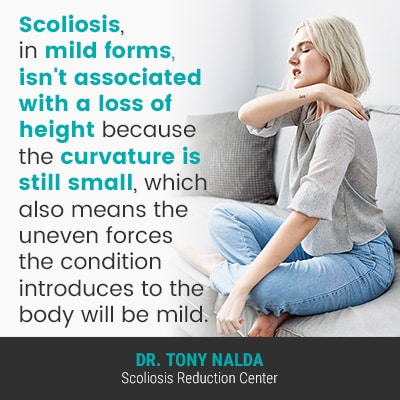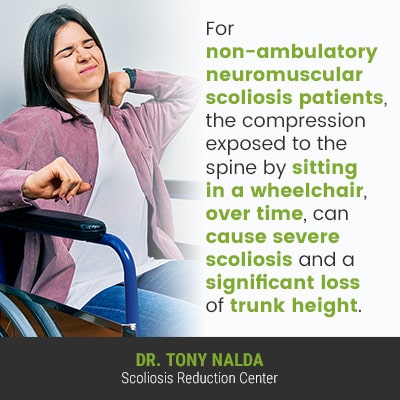Scoliosis is the development of an unnatural sideways spinal curve, so the condition will not make you taller; in fact, it’s associated with a loss of trunk height, particularly in severe forms that are left untreated or not treated proactively.
Many people will experience a decrease in height as they age, and this is related to natural age-related spinal degeneration, but for people with scoliosis, a loss in height is related to the overall health and function of the spine.
Before getting to the specifics of how scoliosis can affect height, let’s first address some basic spinal anatomy, and condition characteristics, for a better general understanding of how scoliosis and scoliosis surgery can affect height.
4 Key Takeaways
- Impact of Scoliosis on Height: Scoliosis can lead to a loss of trunk height, especially in severe cases, due to the development of an unnatural sideways spinal curve which disrupts the spine’s healthy, straight alignment and its ability to support vertical height.
- Scoliosis Severity and Structural Impact: The severity of scoliosis, measured by the Cobb angle, can vary widely, affecting height and posture differently. As scoliosis progresses, the increasing curvature can exacerbate height loss and structural deformities, necessitating personalized treatment approaches.
- Scoliosis Surgery’s Limitations on Height Gain: While scoliosis surgery, such as spinal fusion, can correct spinal alignment and potentially restore some lost height, it is not intended to make individuals taller. The primary goal is stabilizing the spine and addressing the curvature, with any height gain being a secondary effect.
- Proactive Treatment and Height Restoration: Proactive and comprehensive scoliosis treatment that integrates various disciplines, such as chiropractic care and physical therapy, can help restore lost trunk height. However, it does not make individuals taller than their pre-scoliosis stature, focusing instead on reducing curvature and improving posture.
Anatomy of the Spine and Vertical Height
There are many variables that factor into a person’s height, genetics and posture being two significant ones.
In addition, spinal health also factors in, so let’s spend a moment talking about the anatomy of a healthy spine. A healthy spine will appear straight when viewed from the front and/or back, and take on a soft ‘S’ shape when viewed from the sides.
The spine’s healthy curves make it stronger, more flexible, and better able to absorb mechanical stress that’s incurred during movement. There are three main spinal sections: cervical (neck), thoracic (middle/upper back), and lumbar (lower back).
The spine consists of vertebrae (bones of the spine) stacked on top of one another in a straight and neutral alignment, and adjacent vertebrae are separated by the spine’s intervertebral discs.
The spinal discs are generally the first spinal structures to feel the effects of deterioration, and they help facilitate spinal flexibility, provide cushioning between vertebrae, and act as the spine’s shock absorbers.
In addition, the discs are essential to the spine’s structure as adjacent vertebrae attach to the disc in between, so if a disc changes shape due to deterioration and becomes desiccated, bulging, or herniated, it can lose height, and affect the position of near-by vertebrae.
If one or more of the spine’s vertebrae shift out of alignment with the rest of the spine, this disrupts the spine’s overall health, function, and biomechanics.
For people diagnosed with scoliosis, regardless of what their height is at the time, scoliosis does have the potential to affect a person’s height, especially when severe, and not to increase height, but to decrease it.
Scoliosis, a condition characterized by a sideways curvature of the spine, can occasionally lead to a temporary increase in height following surgical interventions, such as spine-straightening surgery, but it’s important to note that this increase is a result of correcting the spinal deformity rather than a primary goal of the surgery.
Spinal fusion is a surgical procedure to address spine-related issues, but it doesn’t make you taller; its primary goal is to stabilize the spine and alleviate problems like scoliosis or disc herniation.
Scoliosis Severity
Scoliosis is a highly-variable condition that ranges from mild to moderate and severe to very severe, and in order to be diagnosed with scoliosis, certain parameters have to be met.
The development of an unnatural sideways spinal curve has to have a rotational component, making it a 3-dimensional condition.
A measurement known as Cobb angle, taken during X-ray, tells me how far out of alignment a scoliotic spine is and places conditions on a severity scale:
- Mild scoliosis: Cobb angle measurement of between 10 and 25 degrees
- Moderate scoliosis: Cobb angle measurement of between 25 and 40 degrees
- Severe scoliosis: Cobb angle measurement of 40+ degrees
- Very-severe scoliosis: Cobb angle measurement of 80+ degrees
As you can see from the wide range of Cobb angle measurements, scoliosis is a highly-variable condition, which is why the very nature of scoliosis necessitates a customized treatment approach.
In mild forms, functional deficits are rare, and postural changes tend to be subtle, but as a progressive condition, where a scoliosis is at the time of diagnosis is not indicative of where it will stay.

Scoliosis, in mild forms, isn’t associated with a loss of height because the curvature is still small, which also means the uneven forces the condition introduces to the body will be mild.
Scoliosis being progressive means it has it in its very nature to worsen over time, particularly if left untreated, or not treated proactively, so where a scoliosis is at the time of diagnosis is not indicative of where it will stay.
As scoliosis progresses, the unnatural sideways spinal curve is increasing in size, and in most cases of scoliosis, this is when the condition’s symptoms tend to become less subtle and more overt.
In addition to ranging widely in severity, there are different types of scoliosis a person can develop, so let’s talk about how the different types can affect height, particularly in severe forms.
Different Types of Scoliosis
The most prevalent form of scoliosis is adolescent idiopathic scoliosis (AIS), diagnosed between the ages of 10 and 18.
Idiopathic scoliosis is not associated with a single clear causative source, and is also the most common type to affect adults.
A big factor in determining the different types of scoliosis is causation, so let’s move on to the condition types that are associated with known causes.
Scoliosis Types with Known Causes
Approximately 80 percent of known diagnosed scoliosis cases are classified as idiopathic, while the remaining 20 percent are associated with known causes, some more severe and more likely to affect spinal height than others.
Neuromuscular scoliosis (NMS), for example, is caused by the presence of a larger neuromuscular condition, such as muscular dystrophy, cerebral palsy, and spina bifida.
In cases of NMS, there is a disruption to brain-body communication, the muscles, and/or connective tissues that support the spine.
Because NMS is a severe form that can cause individuals to become wheelchair-bound, clearly, height is affected, and in treatment, the underlying neuromuscular condition has to be the guiding force of treatment.

For non-ambulatory neuromuscular scoliosis patients, the compression exposed to the spine by sitting in a wheelchair, over time, can cause severe scoliosis and a significant loss of trunk height.
Levoconvex scoliosis, a type of spinal curvature, can affect posture and spinal alignment, potentially influencing height perception in individuals with scoliosis.
Another form of scoliosis with known causation is degenerative scoliosis, and this form is caused by natural age-related spinal degeneration, plus can be exacerbated by the cumulative effect of negative lifestyle choices that can occur over time.
In degenerative scoliosis, it’s most often the spinal discs that are experiencing deterioration that affects the rest of the spine, and in particular, the positioning of adjacent vertebrae, and if a disc becomes desiccated, it loses height, which, over time, and particularly if more than one disc is affected, will result in a loss of the spine’s vertical height.
But what if scoliosis is treated successfully? Can the treatment actually make you taller?
Can Scoliosis Make You Taller? Can Scoliosis Surgery Make You Taller?
So now that we know the different ways in which scoliosis can make you shorter, what about the reverse?
If scoliosis is treated effectively, can a curvature reduction actually restore, and improve, a person’s height?
Basically, there are two main forms of treatment: traditional and conservative.
In traditional treatment, a common question asked is can scoliosis surgery make you taller, because patients are often funneled towards spinal surgery.
In fact, the main reason patients opt for revision surgery is cosmetic; patients can feel that surgery is the only way to restore their pre-scoliosis bodies and reverse the condition’s postural effects.
While scoliosis itself does not make you taller, addressing scoliosis and improving spinal alignment through posture correction can potentially increase height.
Height alterations due to scoliosis are often pondered, with individuals questioning how much height the condition may affect and whether they would be taller without scoliosis.
The reality, however, is that corrective surgery can help straighten a crooked spine, which might improve height slightly by facilitating a person’s ability to stand up straighter, as the surgery focuses solely on the spine, other postural changes, such as uneven hips and one shoulder sitting higher than the other are not the focus of the procedure.
While scoliosis primarily affects spinal curvature, it may indirectly influence body posture, potentially causing the stomach to stick out and affecting overall body appearance. Additionally, building muscle won’t make you taller, scoliosis can affect your height, as the curvature of the spine might cause a loss of height; however, spine growth after 18 is typically minimal, as most height development has already occurred by this age.
In addition, as screws are attaching rods to the spine to hold it in a corrective position, this can cost the spine in terms of its overall health and function.
Through conservative treatment, a curvature reduction on a structural level is worked towards through condition-specific chiropractic care, and other treatment disciplines are applied to increase core strength, so the spine is optimally supported by its surrounding muscles and augment corrective results.
Through this type of approach, reducing a scoliotic curve on a structural level can help counteract the postural changes caused by the condition, and this can restore a degree of lost height, although there is no formula to determine exactly what type of height gain can be expected.
As the connection between a loss of height and scoliosis is linked to condition severity, the application of proactive treatment to reduce a curve can help restore a loss of trunk height but won’t make a person taller than they were prior to developing scoliosis.
While scoliosis can’t make you taller, it can indeed affect your height by causing spinal curvature, altering what scoliosis looks like from a straight spine, and leading to a range of physical issues, including muscular imbalances, rib humps, and mild scoliosis, all of which can contribute to changes in your overall posture, weight and appearance.
Scoliosis is a condition characterized by the lateral curvature of the spine, typically measured in degrees of curvature. While scoliosis surgery for adults can be an option to correct spinal deformity, it is essential to understand that the primary goal of such surgery is to improve spinal alignment and posture, fix uneven shoulders, and alleviate scoliosis pain and discomfort.
However, scoliosis surgery is not designed to make a person taller. The potential height gain, if any, would be a result of the improved spinal alignment and posture rather than the direct objective of the surgery. Engaging in activities like swimming with scoliosis can also help maintain flexibility and overall well-being, but any impact on height would be minimal.
Swimming is a great form of exercise, but it does not have a direct impact on increasing your height, particularly in relation to scoliosis, as scoliosis primarily affects the curvature of the spine rather than height.
Scoliosis, a condition characterized by spinal curvature, does not typically result in a person getting taller. However, some individuals may experience a slight increase in height after scoliosis surgery, while others may explore chiropractic treatments in the hope of height gain, but these outcomes can vary significantly from person to person.
Conclusion
So can scoliosis make you taller: no. Scoliosis is associated with a loss of trunk height due to the fact that the spine bends unnaturally to the side, making it harder to stand upright and disrupting the body’s overall symmetry.
Scoliosis can indeed make you shorter, as the abnormal curvature of the spine can cause a reduction in height over time. However, standing up straighter might make you appear taller, but scoliosis itself does not increase overall height; however, correcting spinal curvature can enhance one’s posture, giving the illusion of added height.
While scoliosis itself does not make you taller, engaging in spine stretches can help improve posture and spinal alignment, which may contribute to a slight increase in height.
Can scoliosis correction surgery make you taller? While scoliosis surgery can help straighten a crooked spine and restore some lost height that way, it will not make you taller, nor will it necessarily address any of the other postural changes associated with the condition.
The only way to restore a loss of trunk height caused by the development of an unnatural sideways spinal curve is through proactive treatment that addresses the condition’s underlying structural nature.
Here at the Scoliosis Reduction Center®, I address scoliosis symptoms, such as postural deviation and a loss of trunk height, with proactive treatment that integrates multiple treatment disciplines to impact conditions on every level.




